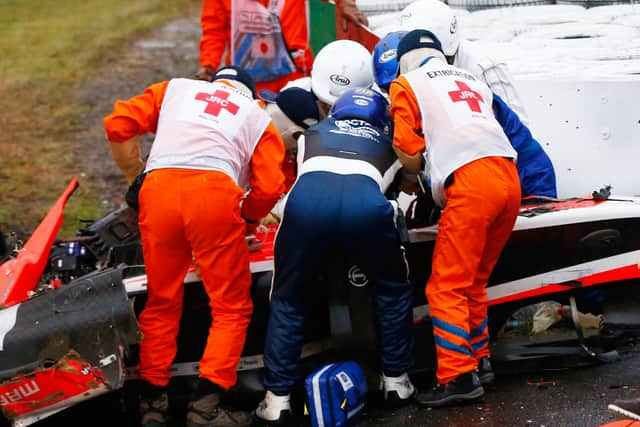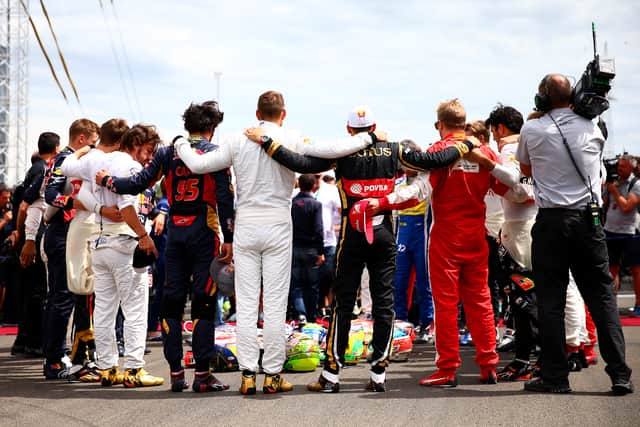Tributes paid to Jules Bianchi on anniversary of his death - who was the Formula 1 driver and how did he die?
and live on Freeview channel 276
Ferrari has led tributes to the late Jules Bianchi on the eighth anniversary of his death. The Italian Formula 1 team took to social media to share a photo of the driver, who died at the age of 25 years old following a crash in 2015.
A tribute shared to the team’s Twitter account read: “Never forgotten. Jules, we miss you dearly”, with McLaren commenting on the picture saying: “Remembering Jules”. Ferrari driver Charles Leclerc, the godson of the late driver, shared a post to his Instagram stories from Bianchi’s father Philippe Bianchi, as he remembered his son on the anniversary of his death.
Advertisement
Hide AdAdvertisement
Hide AdPhilippe shared a photo of him hugging his son following a race, with the caption: “8 years i miss you i love you so sad never forget forever”. Alpine driver Pierre Gasly commented on the post with a heart emoji before sharing the official F1’s memorial post which read: “Along with the whole F1 family, we remember Jules Bianchi today and every day”.
Pierre Gasly has been vocal about the safety of the sport since the passing of his childhood friend, where he emotionally recounted the tragic accident following last year’s Suzuka race where a tractor was brought onto the track during wet weather that caused poor visibility for the drivers.
Tributes have continued to be shared from across the world of motosport as everyone remembers the passing of the 25-year-old.
Who was Jules Bianchi?
Jules Bianchi was born in Nice, France, on August 3, 1989. The Formula 1 driver was born into a motorsportting family, being the grandson of GT racing driver, Mauro Bianchi, and the grandnephew of Formula One driver Lucien Bianchi.
Advertisement
Hide AdAdvertisement
Hide AdBianchi drove as the Ferrari test and reserve driver from 2009 to 2012, also taking the reserve driver role for Force India. In 2013, Bianchi took the driver seat for Marissia and made his debut at the Australian GP.


The following year it was confirmed that Bianchi would stay driving with the team for the following season. The driver took his and his team’s first World Championship points at the Monaco Grand Prix after he finished ninth.
Just days before his fatal accident, Bianchi said that he was “ready” to step into the seat at Scuderia Ferrari should the team need him, following heavy speculation of a departure from Fernando Alsonso.
How did Jules Bianchi die?
Jules Bianchi passed away after a tragic accident at the Japanese Grand Prix in 2014. The race was hosted during days where Typhoon Phanfoe affected the track, causing heaving winds and rainfall during the Grand Prix.
Advertisement
Hide AdAdvertisement
Hide AdThe race was started behind a safety car that drove ahead of the race for the first two laps before the session was red-flagged due to heavy rain. The race eventually went ahead but the track was still wet from the heavy rainfall.
On lap 43, further rain on the track caused Adrian Sutil in the Sauber to lose control of the rear of his car and he hit a wall going into turn 7. As the accident had taken place right next to a marshall’s post, the race director chose not to bring out the safety car and instead opted for double-waved yellow flags as the car was recovered.


Bianchi then lost control of his car, crashing into the recovery vehicle. Following the collision, the driver suffered a diffuse axonal injury which is where the brain’s long connecting nerve fibres tear which occurs when the brain is injured as it shifts and rotates inside the skull.
Bianichi spent nine months in a coma before he passed away on 17 July, 2015. The Formula 1 driver was the first to die from injuries that occurred during a Grand Prix, since the death of Brazilian driver Ayrton Senna in 1994.
Advertisement
Hide AdAdvertisement
Hide AdAfter the crash in Suzuka, the Marussia team ran only one car in the Russian Grand Prix as a sign of respect for Bianchi. Following his death, the Formula 1 drivers and teams came together before the start of the Hungarian Grand Prix to share a minute’s silence for the late driver.
At this race, each of the drivers ran with ‘#JB17’ on their cars to pay tribute to Bianchi.
A number of drivers attended the funeral for Bianchi including Lewis Hamilton, Nico Rosberg and Felipe Massa. Romain Grosjean and Sebastian Vettel helped carry the coffin, on what was described by Hamilton as “a sad, sad day.”


Jules Bianchi legacy
Many changes have come to Formula 1 following the death of Jules Bianchi. After the 2014 season, the FIA introduced the Virtual Safety Car to the race, which forced drivers to immediately slow down when an accident took place.
Advertisement
Hide AdAdvertisement
Hide AdIn 2018, the life-saving Halo was introduced which fits around the cockpit and protected the drivers from flying debris. The Halo has saved countless lives in motorsport including today’s drivers Lewis Hamilton, Fernando Alonso and Charles Leclerc.
The Halo has been brought in across all single-seat racing championships, despite not being liked by many fans and teams when it was first introduced.
Comment Guidelines
National World encourages reader discussion on our stories. User feedback, insights and back-and-forth exchanges add a rich layer of context to reporting. Please review our Community Guidelines before commenting.
